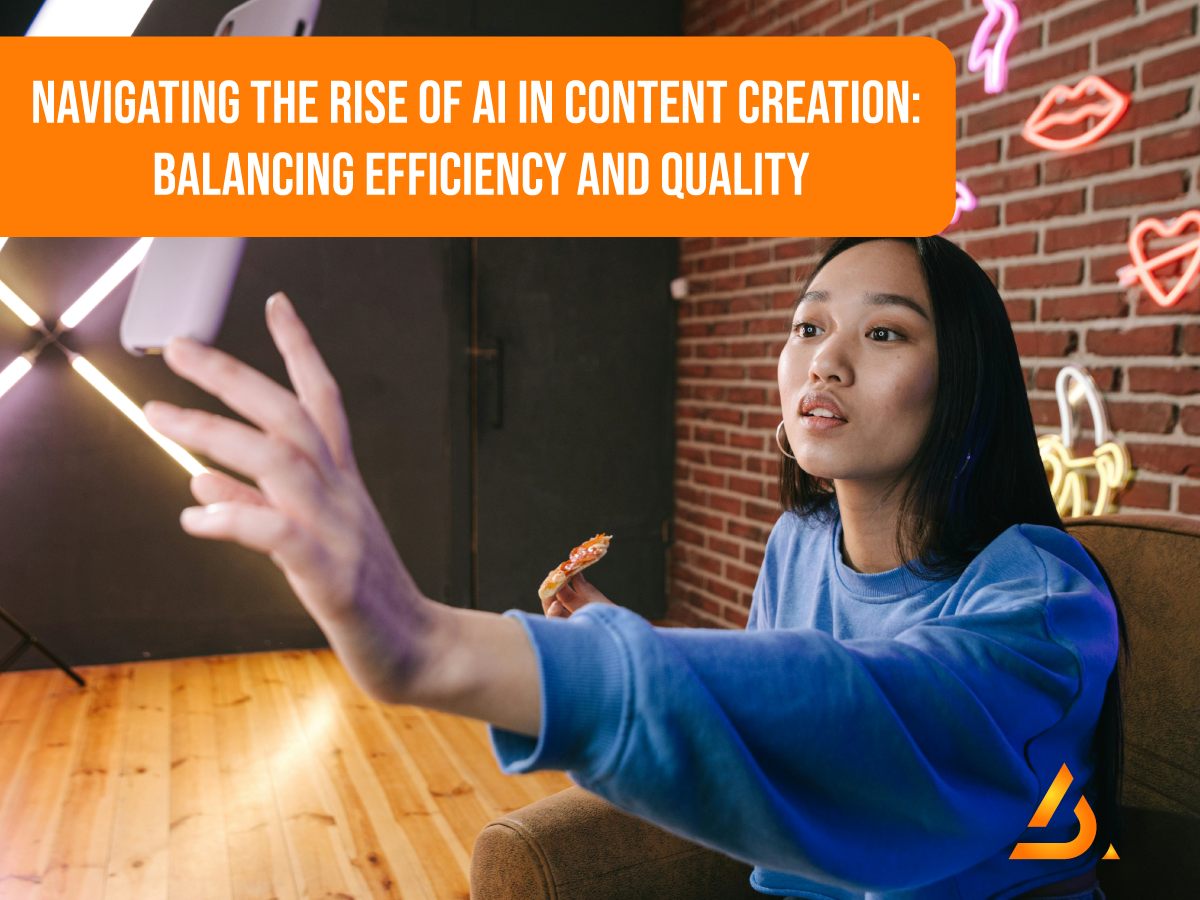Navigating the Rise of AI in Content Creation: Balancing Efficiency and Quality


The advent of AI in content creation has revolutionized the way we produce and consume information. However, with its benefits come challenges that need careful navigation. In this blog post, we'll explore the dual nature of AI content creation, its implications for SEO, and strategies to strike a balance between efficiency and quality.
The Pros and Cons of AI Content Creation
Benefits of AI Content Creation:
-
Improved Efficiency: AI tools are a great help for writers, easing the task of content creation in more streamlined ways that could, in turn, deliver work on time and make resource utilization more efficient. With the automation of routines like research and drafting, content producers free up their time to concentrate on more thought-through responsibilities.
-
Powerful Content Ideation: AI algorithms can suggest creative ideas and explore unusual trends among them. AI-driven content ideation tools nowadays conduct data analysis and trend identification, offering interesting modes of audience preference understanding and theme emergence identification.
-
Rapid Research: The availability of Artificial Intelligence-powered research instruments makes it possible for content to be deep and relevant by bringing in vast data gathering and analysis. Through access to many resources, makers of visuals can easily find credible sources, abstract the information to relevant data points, and compile complex concepts into easily understandable versions that are precise and concise.
Challenges of AI Content Creation:
-
Generic Content: Machine-made content production, though easy and fast, often leads to generic, dull work devoid of fresh and original ideas. Through artificial intelligence (AI) applications, content is created on a large scale, but quality is compromised for quantity, resulting in monotony and theme repetitions in niche narratives.
-
Poorly Written Text: Unattended AI-written content would most probably be often incorrect (spelling and readability-wise), based on current development. While AI algorithms can produce natural language processes, they often lack the nuances of syntax and subtlety of human writing, resulting in prose that is stilted and awkward.
-
Ineffective Content: Such content, lacking the human side and experience of experts, may fail to engage the audience and achieve the intended results. Experts need to mention highly educational and interesting topics. AI robots can create content around pre-set themes, but they are unlikely to incorporate contextual understanding or intellect to reach diverse audiences and make them feel emotionally connected, establishing meaningful communication.
The Two Schools of Thought on AI Content Creation
AI-Only Approach vs. Collaborative Approach:
-
AI-Only Approach: While some advocate for production using AI tools alone, in which writers believe they are capable of simply throwing out publishable content in a short time. The innovative approach by AI mirrors the scaling up and the sensitivity of quality. This is incomparable to conventional AI approaches, which make it possible for organizations to meet the growing demand for content without compromising quality. However, an algorithm rushed to market without any human intervention may deliver below-par results and at times incur damage from search engines.
-
Collaborative Approach: A comprehensive plan includes using AI support along with human-led skills. Through the combination of professional spelling-and-grammar checkers and SEO-compliant editors, companies can ensure that their content meets a certain standard, is up to date, and complies with marketing guidelines. AI is a collaborative model that sees AI technologies as lights to reflect rather than replace the human creative and judicious mind, enabling organizations to capitalize on the best of human skills and AI intelligence. This approach is particularly valuable for any web design company where creativity and technical precision intersect.
Navigating the AI Landscape:
Best Practices for AI Content Creation:
-
Quality Over Speed: Prioritize high-quality content creation that goes beyond satisfying the need for quantity, instead of focusing solely on the speed of the process. Although AI tools are important for their capacity to create content quickly, firms must not succumb to mere trending incentives but prioritize authenticity, relevance, and interactivity for a long-standing relationship.
-
Human Oversight: Oversee human workforce during content creation to ensure posts are seen as actual, accurate, and adhere to your brand standards. While AI tools can be very helpful in automating some aspects of content creation, human editors are necessary to make changes to computer-generated content, identify mistakes, and add creativity and personality to it.
-
Unique Perspective: Include one-of-a-kind thoughtful ideas, interviews with experts, and personal stories to stand out and engage customers. Although AI algorithms can interpret data and tracing emerging trends, human authors provide depth of understanding and empathy that make it possible to create outstanding stories and build affective relationships with readers.
Implementing a Collaborative Content Creation Process
Prework:
-
Define Parameters: Define specific goals, develop personality, topic voice, and the type of content, e.g., video, audio, or text. By generating an initial set of key attributes, organizations can achieve uniformity and synergy while promoting a similar feel throughout the content creation process, projecting their brand in a specific way.
-
Content Creation: The phase of content creation requires you to employ AI features such as finding ideas, writing outlines, performing research, and developing first drafts. Aligning the algorithms for artificial intelligence can contribute to the speed of content production; nevertheless, human engagement remains vital for improving the quality of AI-generated content to provide relevance, accuracy, and readability.
Balancing Automation and Collaboration
Strategic Integration: Use the power of artificial intelligence as enablers and not replacements to human creativity and knowledge by showing a balance between AI and human labor. AI algorithms can convert to automation and perform certain tasks faster and more efficiently compared to human writers and editors, but the latter add the element of a bigger strength: emotional intelligence, which is necessary in creating a true and attractive story for it to connect with the readers.
Final Thoughts
In the long run, AI emergence creates a new content area, but not everybody appreciates the probability of unfavorable consequences, so organizations are forced to go not only by digital implementation but also to mix it with the traditional ones. By putting quality on the pedestal, ensuring its relevancy, and orienting it towards the user as important components, companies can circumvent the complexities of AI content creation and still be ready for changes in search engine algorithms. Subsequently, the main element of winning is, in fact, the art of using AI as a device to synthesize human creativity and enabling knowledgeable content experience, which is not only appealing to the audience but also enables meaningful interaction.
- Art
- Causes
- Crafts
- Dance
- Drinks
- Film
- Fitness
- Food
- Games
- Gardening
- Health
- Home
- Literature
- Music
- Networking
- Other
- Party
- Religion
- Shopping
- Sports
- Theater
- Wellness
- IT, Cloud, Software and Technology


